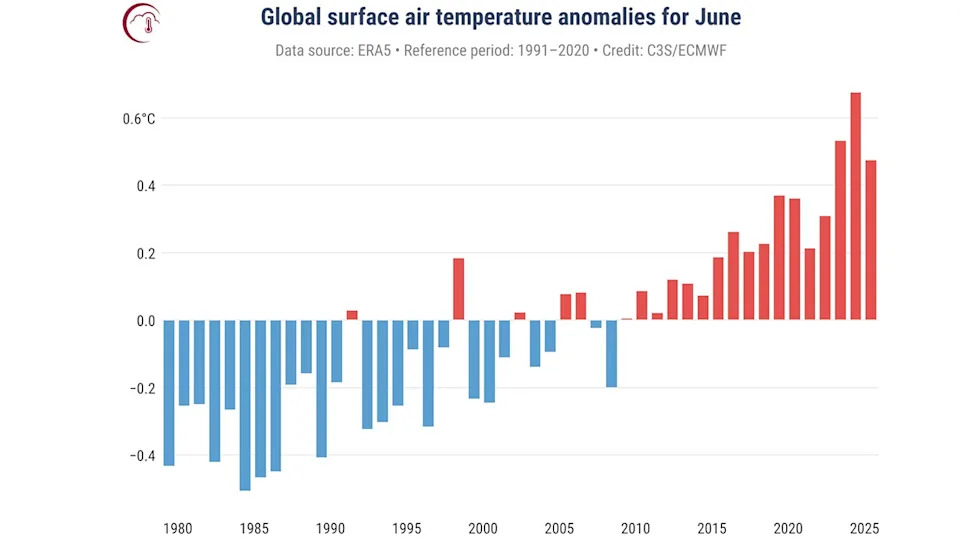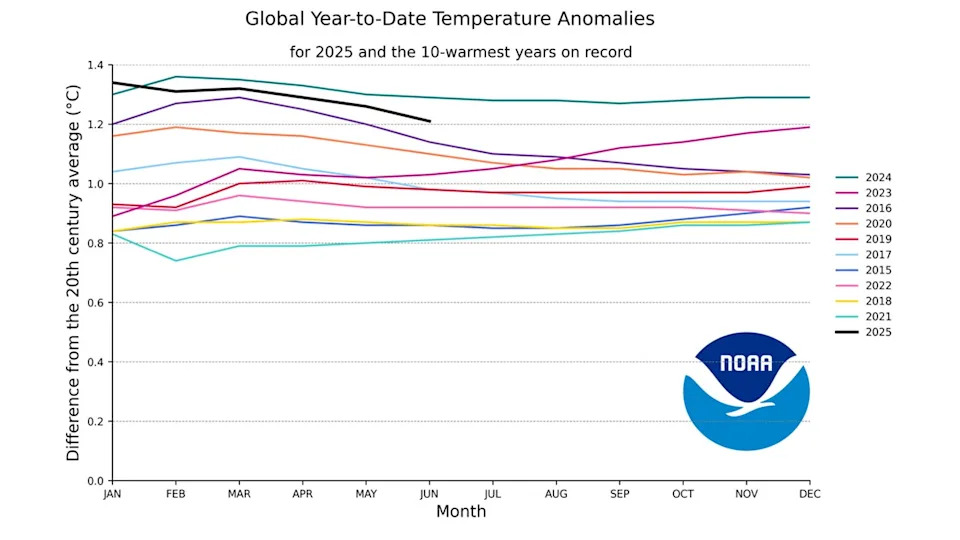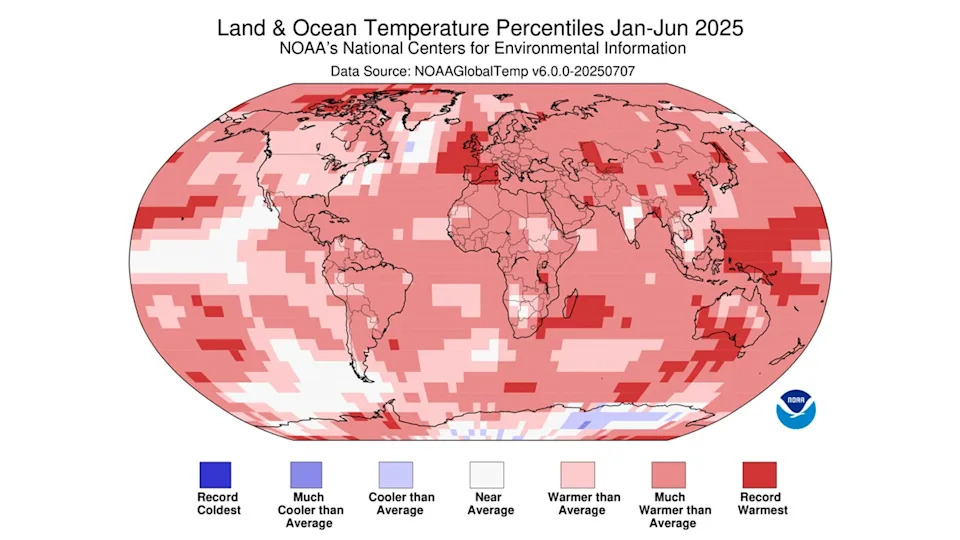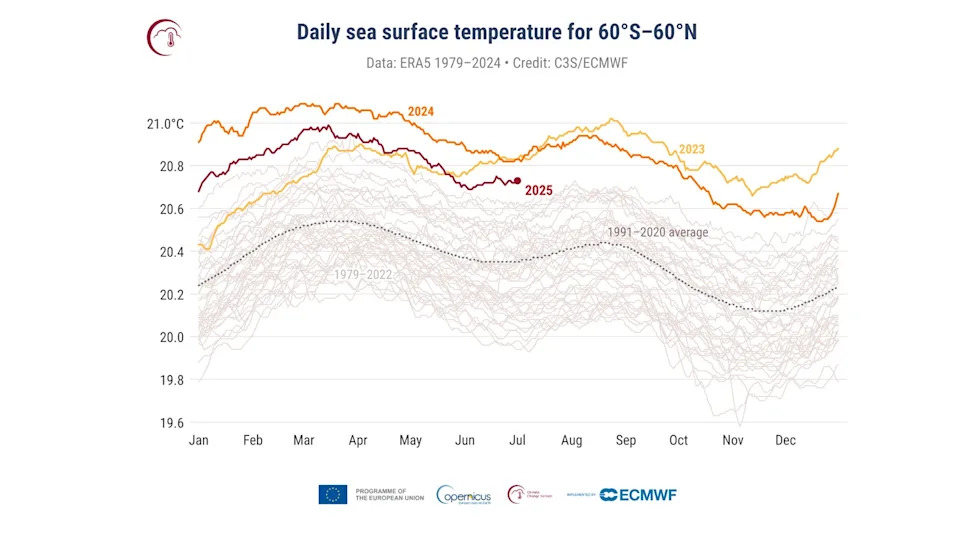2025 Pacing As Earth's Second Warmest Year Behind 2024, Report Says
The first six months of 2025 were Earth's second warmest on record, keeping 2025 on a pace to finish slightly behind 2024 for the planet's warmest year, according to just-released data from several agencies.
June's warmth: June 2025's globally average temperature was 1.76 degrees Fahrenheit above the 20th-century average, only 0.42 degrees cooler than the record warmest June in 2024 and 0.18 degrees cooler than the second warmest June in 2023, according to a report released Thursday by NOAA.
Separate analysis from the European Copernicus Climate Change Service (C3S) and NASA's Goddard Institute for Space Studies also found Earth had its third warmest June, behind the two previous Junes.
 June 2025 C3S global temperatures
June 2025 C3S global temperaturesOnly Behind Last Year: With the first six months over, 2025 has a roughly 2 in 3 chance to be the planet's second warmest year on record, climate scientist Zeke Hausfather estimated in a post on Bluesky.
NOAA similarly concluded "95% confidence" of a second to fourth warmest year on record in 2025 in their temperature rankings outlook. NOAA global temperature records date to 1850.
Each month in 2025 has been at least among the top three warmest of those respective months, according to NOAA. January was the planet's warmest in 176 years, NOAA found.
2024 was the planet's warmest year in records dating to the late 19th century, according to both NOAA and NASA.
(For even more granular weather data tracking in your area, view your 15-minute details forecast in our Premium Pro experience.)
 NOAA horserace 2025 versus other warm years June 2025
NOAA horserace 2025 versus other warm years June 2025Above The Threshold? June 2025 was only the third in the last 24 months in which global temperatures were not more than 2.7 degrees Fahrenheit (1.5 degrees Celsius) above the pre-industrial (1850-1900) levels, according to the C3S.
Despite that, the most recent 12-month period through June was more than 2.7 degrees above late 19th-century temperatures.
That doesn't necessarily mean we've broken above the 2.7 degree limit agreed upon in the 2015 Paris Climate Agreement.
According to climate scientists, that would require that threshold to be topped for over a decade. But they also stress it means we're closer to that threshold than ever before.
(Further beef up your forecast with our detailed, hour-by-hour breakdown for the next 8 days – only available on our Premium Pro experience.)
Highlights: June was the warmest on record in Japan, as well as in dozens of cities in South Korea. It was the second warmest June in France and the United Kingdom.
Spain smashed its national June heat record on June 28, when a high of 114.8 degrees was measured in El Granado, according to NOAA.
In the U.S., it was the hottest June on record in Raleigh, North Carolina, and Yakutat, Alaska, according to the Southeast Regional Climate Center.
As you can see on the map below, parts of western Europe, Australia and Asia were record warm in the first six months. Hawaii had its hottest January-June on record, according to NOAA.
 NOAA January through June 2025 global temperatures
NOAA January through June 2025 global temperaturesOceans still warm: Global ocean temperatures are still much warmer than in any years from 1979 through 2022, C3S found.
C3S noted that since March 2023, global daily sea surface temperatures have been warmer than in other years prior.
Among patches of ocean record warmth in the first six months of 2025 included swaths of the Philippine Sea, the Pacific Ocean near Hawaii, the northeast Atlantic Ocean near Ireland, the U.K. and Scandinavia, the western Mediterranean Sea, the Arctic Ocean from Greenland to Canada and the southern Indian Ocean.
Despite all that, 2025's ocean warmth has been less extreme than the off-the-charts ocean warmth of 2023 and 2024, which included both record tropical Atlantic warmth and an El Niño, the periodic warming of water in the equatorial eastern and central Pacific Ocean.
 Global SSTs year to date 2025 C3S
Global SSTs year to date 2025 C3SJonathan Erdman is a senior meteorologist at weather.com and has been covering national and international weather since 1996. Extreme and bizarre weather are his favorite topics. Reach out to him on X (formerly Twitter), Threads, Facebook and Bluesky.










![LED Billboard Market Latest Report: Valuation and Growth Insights {2029} [3780.56M, 9.1%]](https://noticiasdecostarica.com/zb_users/upload/2025/07/20250714015451175242929125907.png)

![Laundry Capsules Market: Anticipating Robust Growth Analysis [CAGR 10.9%]](https://noticiasdecostarica.com/zb_users/upload/2025/07/20250713221554175241615494091.png)
